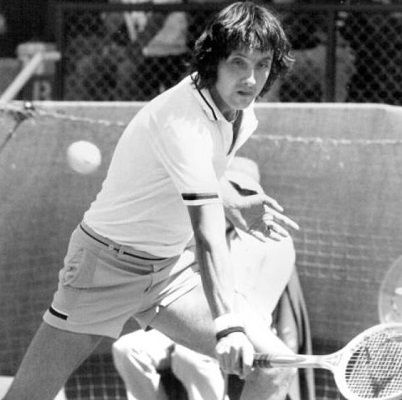
What do you do when 80-some players pull out of your 128-man draw? It wasn’t exactly an option to skip Wimbledon or proceed with a compressed field, just because an upstart players’ union full of money-grubbing Americans wanted to make a point.
Referee Mike Gibson began by sending out a few invitations. 30-year-old New Yorker Herb Fitzgibbon was semi-retired, working as a stockbroker. Perhaps because he had beaten Niki Pilić at the Championships in 1968, Fitzgibbon got a wire telling him he didn’t need to qualify. He left his desk and headed to London.
When the withdrawals started rolling in, the qualifying tournament was underway. It quickly became clear that the 128-strong group of aspirants didn’t need to be whittled down as much as usual. The third qualifying round was never played: There would be 32 qualifiers instead of the traditional 16.
So many ATP members took their names out of the running that soon, every man who had reached the second round of qualifying was in. Even that wasn’t enough, especially when some of the lucky losers decided to back the boycott. Sherwood Stewart was one such prominent case. Stewart’s doubles partner Dick Dell was another. Dell’s older brother, Donald, was one of the ATP’s founders. As soon as Bob Maud found out he got a second-chance entry into the main draw, union representatives tracked him down and convinced him to stay out.
Ultimately, there were 49 lucky losers in the men’s draw, some of whom had failed to win a single qualifying match. That left former British Davis Cupper Paul Hutchins with a painful what-if to contemplate. Like Fitzgibbon, he was semi-retired with a day job. He entered the qualifying event, but on the first day of play, he was busy at work. He figured he didn’t have much of a chance anyway, so he called in to scratch. A few days later, he learned that had he simply shown up and lost, he could have gotten a place in the main draw.
Hutchins might have made way for Californian Dick Bohrnstedt, the luckiest loser of all. A successful qualifier in 1972, Bohrnstedt wasn’t in the draw for the 1973 preliminaries because his entry got lost. He made it in as an alternate only to lose to Australian John Bartlett in his opening match. He was given a main-draw spot anyway.
British pundits put on a brave face. “I dare say the normal excitement and tension will be far from lacking,” wrote the estimable Lance Tingay. “[A]fter all, the competitors who came in from the qualifying rounds are far from poor players.”
Some of them, anyway. 18-year-old South African Bernard Mitton was another loser in first-round qualifying. He took advantage of his good fortune–and a draw packed with journeymen–to reach the second week of the main draw. He wasn’t even the only lucky loser in the fourth round.
The real hope for the men’s tournament rested with the few stars who chose to play. ATP member Ilie Năstase defied the boycott on the orders of his national federation. When defending champion Stan Smith withdrew, Năstase became the top seed and an overwhelming favorite to win the title. Non-union youngsters Jimmy Connors and Björn Borg were moved onto the seeding list, at 5th and 6th, respectively.
The home fans would follow another ATPer, Britain’s own Roger Taylor. While union members debated whether Taylor would be shunned or merely held at arm’s length for breaking the boycott, the left-hander came within a whisker of winning the title at Queen’s Club. On June 23rd, he lost to Năstase, 9-8, 6-3, in a match with only one break of serve. Taylor would be the third seed at the All-England Club. In Tingay’s opinion, “there never was a better chance of a British men’s winner for 35 years.”
With two days left before the Championships kicked off, the press contingent had plenty of work to do. When they weren’t writing columns lambasting Jack Kramer for destroying the game, they had dozens of new names and faces to learn. This would not be a typical Wimbledon.
* * *
This post is part of my series about the 1973 season, Battles, Boycotts, and Breakouts. Keep up with the project by checking the TennisAbstract.com front page, which shows an up-to-date Table of Contents after I post each installment.
You can also subscribe to the blog to receive each new post by email: